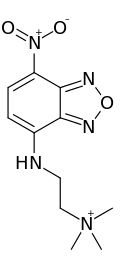NBD-TMA
NBD-TMA ([2-(4-nitro-2,1,3-benzoxadiazol-7-yl)aminoethyl]trimethylammonium) is a small, positively charged (+1) fluorescent dye. It was also known as EAM-1 (N,N,N,-Trimethyl-2[(7-nitro-2,1,3-benzoxadiazol-4-yl)amino]ethanaminium iodide) when it was briefly supplied by Macrocyclics Company as an iodide complex.
 | |
| Names | |
|---|---|
| IUPAC name
N,N,N-Trimethyl-2-[(7-nitro-2,1,3-benzoxadiazol-4-yl)amino]ethanaminium | |
| Identifiers | |
3D model (JSmol) |
|
| ChemSpider | |
PubChem CID |
|
| |
| |
| Properties | |
| C11H16N5O3+ | |
| Molar mass | 266.28 g/mol |
Except where otherwise noted, data are given for materials in their standard state (at 25 °C [77 °F], 100 kPa). | |
| Infobox references | |
NBD-TMA has an excitation maximum at 458 nm and an emission maximum at 530 nm. It also has a smaller local excitation maximum around 343 nm. The molar extinction coefficient is about 13,000 cm−1M−1 and its overall effective fluorescence is about 1% that of fluorescein. It is only mildly sensitive to halide ion collision quenching.
NBD-TMA was designed as a probe for monitoring renal transport of organic cations. As a small, positively charged fluorophore, it has also seen use as a tracer for measuring gap junction coupling in cases of cation selective connexin channels.